Ever wondered what lies behind the Agile Manifesto? Well, wonder no more because we’re about to unveil its secrets. The Agile Manifesto is like a compass guiding us through the ever-changing landscape of software development. It’s a mindset that empowers us to adapt, collaborate, and deliver exceptional results.
Gone are the days of rigid plans and endless documentation. Instead, we embrace flexibility, customer satisfaction, and continuous improvement. In this article, we’ll embark on a thrilling expedition to explore the core principles of the Agile Manifesto.
We’ll uncover how it has revolutionized the way we work, fostering creativity, efficiency, and a deep sense of purpose. So, fasten your seatbelts and get ready to embark on this exhilarating journey into the heart of Agile!
Agile Manifesto History, Origin, and Creators
First things first, let’s dive into the history, origin, and creators of the Agile Manifesto.
The Origin of the Agile Manifesto
Back in 2001, a group of seventeen software developers gathered at a ski resort in Utah, USA. They came together to discuss their shared frustrations with traditional software development methodologies and their desire for a more adaptive and flexible approach. This meeting marked the birth of what is now known as the Agile Manifesto.
The Creators of the Agile Manifesto
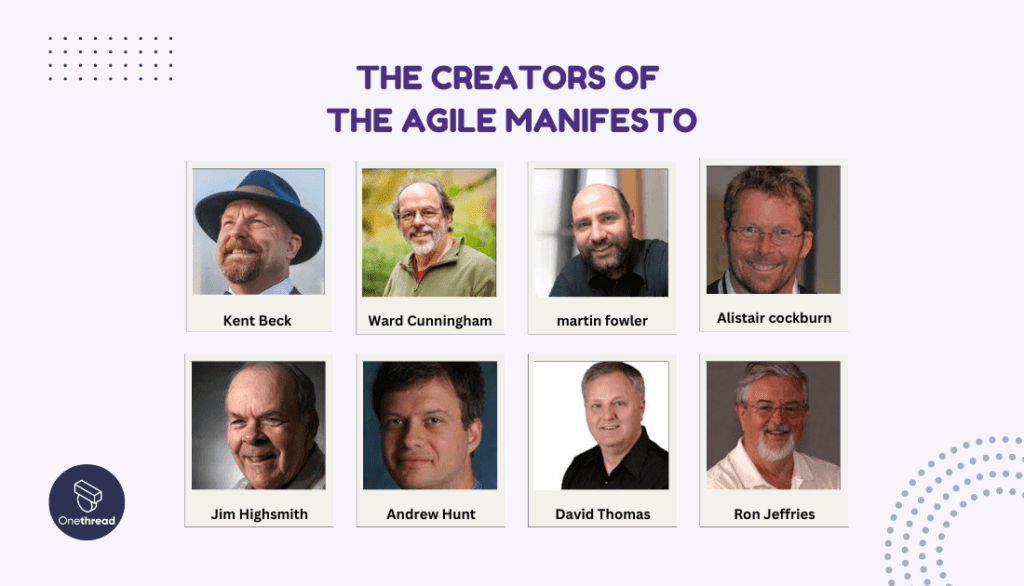
The Agile Manifesto was a collaborative effort by these seventeen individuals, who are often referred to as the “founding fathers” of Agile. This group consisted of prominent figures in the software industry, including:
- Kent Beck: Famous for his work on Extreme Programming (XP) and Test-Driven Development (TDD).
- Ward Cunningham: Recognized as the maker of the first wiki and an advocate for object-oriented programming.
- Martin Fowler: An influential author and software development thought leader.
- Alistair Cockburn: An expert in the field of software development methodologies.
- Jim Highsmith: A prominent advocate for adaptive software development.
- Andrew Hunt and David Thomas: Co-authors of the book “The Pragmatic Programmer.”
- Ron Jeffries: An early adopter and promoter of XP.
The Agile Manifesto
After several days of intense discussions and debates, the group formulated the Agile Manifesto. It is a concise declaration of four key values and twelve principles that form the foundation of Agile software development. These values and principles emphasize individuals and interactions, working software, customer collaboration, and responding to change.
Why Is the Agile Manifesto Important?
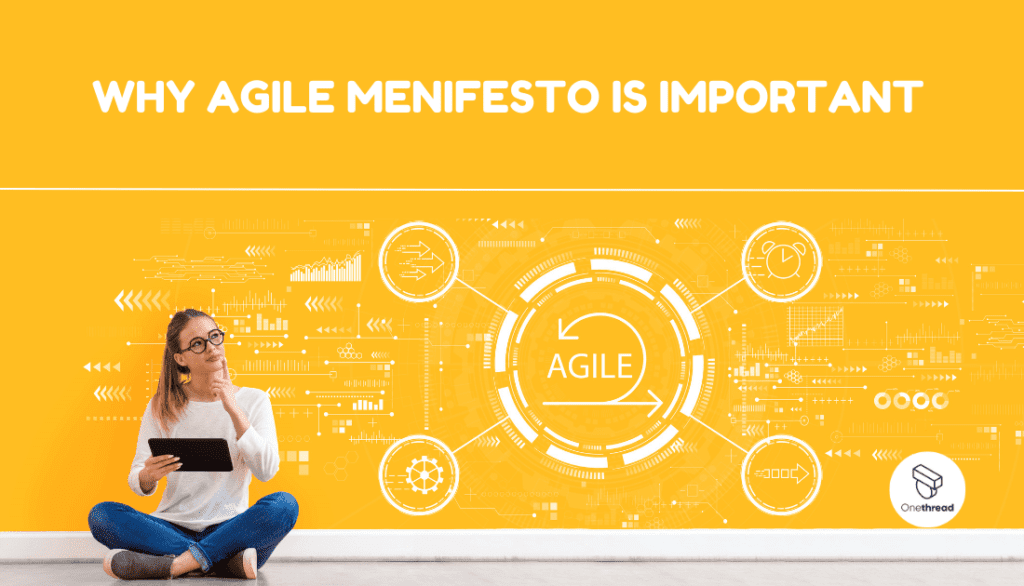
By embracing the Agile Manifesto, organizations can foster a collaborative, customer-focused, and adaptable culture. The Agile Manifesto holds significant importance in the software development industry for several reasons:
Adaptability and Flexibility
The Agile Manifesto promotes an adaptive and flexible approach to software development. It acknowledges that requirements and priorities are subject to change, and it provides a framework for teams to respond effectively to those changes.
Customer Satisfaction
By prioritizing customer collaboration and working tools like Onethread, the Agile Manifesto places a strong emphasis on delivering products that meet customer needs and expectations.
This customer-centric approach fosters better communication, feedback, and collaboration, resulting in a higher likelihood of customer satisfaction and a product that truly addresses their requirements.
Collaboration and Teamwork
The Agile Manifesto values individuals and interactions, emphasizing the importance of effective collaboration within development teams. This fosters a sense of ownership, collective responsibility, and shared goals.
By working closely together, teams can leverage diverse skills and perspectives to produce high-quality software.
Continuous Improvement
Agile methodology, driven by the principles of the Agile Manifesto, promotes a culture of continuous improvement. Teams regularly reflect on their processes and seek ways to enhance efficiency, quality, and productivity.
Its focus on learning and adaptation contributes to the overall growth and success of both individuals and the organization.
Early and Frequent Delivery
Agile methodologies encourage iterative and incremental development, aiming to deliver working software in smaller increments. This approach enables early validation, feedback, and validation from stakeholders, minimizing the risk of developing a product that does not meet requirements or market demands.
What Are The 4 Values of Agile?
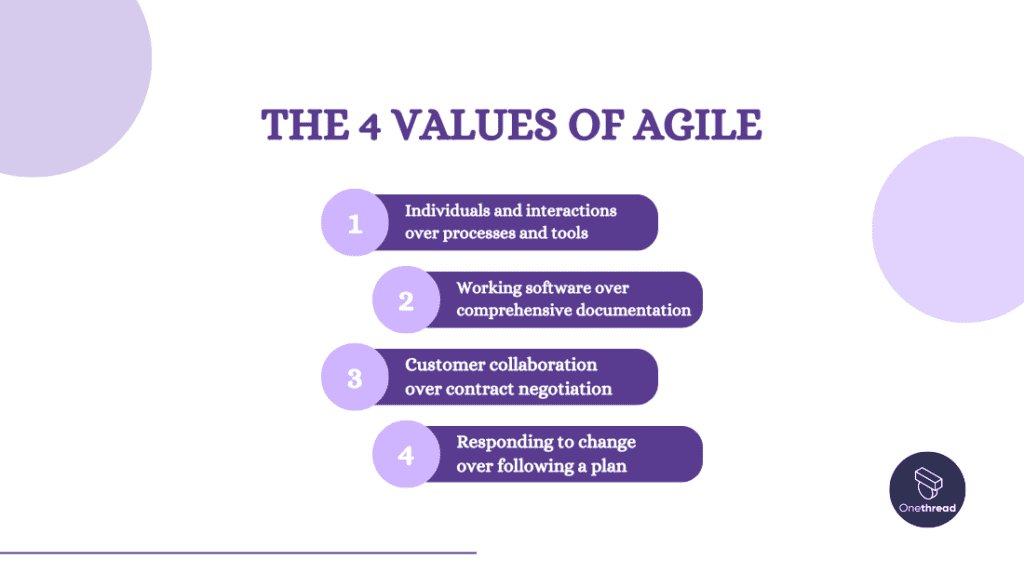
The Agile Manifesto outlines four core values that are foundational to Agile software development. All four values provide a guiding framework for teams to foster collaboration, prioritize working software, engage customers, and adapt to change. Let’s explore each of these values:
- Prioritizing People and Interaction Above Processes and Tools:
Valuing interactions and team dynamics over tools and methodologies underscores the significance of effective collaboration, communication, and teamwork within the development group. Agile emphasizes creating a supportive environment that enables individuals to contribute their unique skills.
Organizations can also leverage custom software development services to build tailored solutions that align with Agile principles, ensuring that the tools and processes support the team’s collaborative and adaptive approach to software development.
- Emphasizing Functional Software Over Extensive Documentation:
Agile places a strong focus on delivering operational software that adds value to the customer. While documentation is important, the central goal is to produce working software that can be tested, validated, and utilized effectively.
- Promoting Customer Engagement Over Contract Negotiation:
Agile recognizes the importance of involving customers actively throughout development. Regular collaboration with customers helps to understand requirements, gather feedback, and validate software functionality. This approach strengthens the partnership and ensures the product aligns with customer expectations.
- Adapting to Change Rather Than Rigidly Following Plans:
Agile acknowledges the inevitability of change in custom software development. Prioritizing adaptability allows us to respond to evolving requirements, market conditions, and feedback. Agile methodologies enable adjustments and prioritization based on changing circumstances, fostering opportunity and risk management.
What’s the Purpose of the Agile Manifesto?
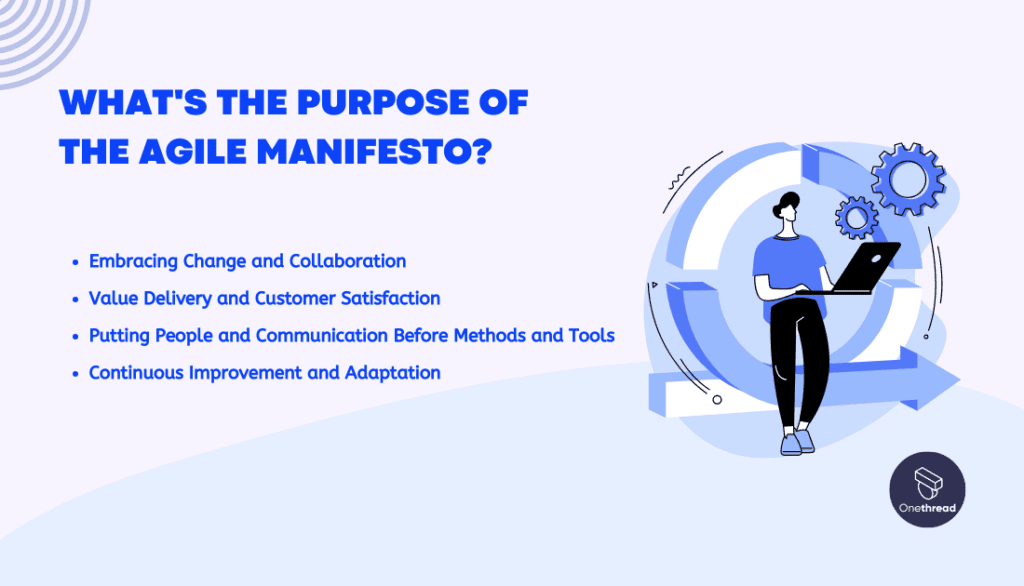
The Agile Manifesto serves as a guiding principle for software development teams, emphasizing the values and principles that contribute to effective and efficient project delivery.
It was created by a group of experienced software professionals in 2001 who sought to address the limitations and challenges of traditional, rigid development methodologies. Let’s dive into the purpose of the Agile Manifesto and how it benefits software development.
Embracing Change and Collaboration
At the core of the Agile Manifesto is the recognition that change is inevitable in software development. Instead of resisting change, Agile encourages us to embrace it as a valuable opportunity to improve our processes and deliver better products. It promotes rapid feedback loops, enabling us to respond to changing requirements and deliver incremental value.
Value Delivery and Customer Satisfaction
Agile emphasizes the delivery of working software in short, iterative cycles known as sprints or iterations. This iterative approach allows us to prioritize the most valuable features and deliver them early, providing tangible value to customers sooner.
Through engaging customers during development and integrating their input, Agile guarantees the final product aligns with their requirements, leading to heightened customer contentment.
Putting People and Communication Before Methods and Tools
The Agile Manifesto recognizes the importance of people and their interactions in the development process. It values effective communication, collaboration, and self-organizing teams over rigid processes and excessive reliance on tools.
By fostering an environment that encourages open communication, trust, and shared responsibility, Agile empowers individuals to make decisions, adapt to change, and deliver high-quality software.
Continuous Improvement and Adaptation
Agile promotes a culture of continuous improvement, where teams reflect on their work regularly and seek ways to enhance their processes and outcomes. Through frequent retrospectives, teams can identify areas for improvement, celebrate successes, and adapt their practices accordingly.
This iterative and adaptive mindset enables teams to respond effectively to changing market conditions and customer needs, ensuring that software development remains flexible and responsive.
A Detailed Discussion on the 12 Agile Manifesto Principles
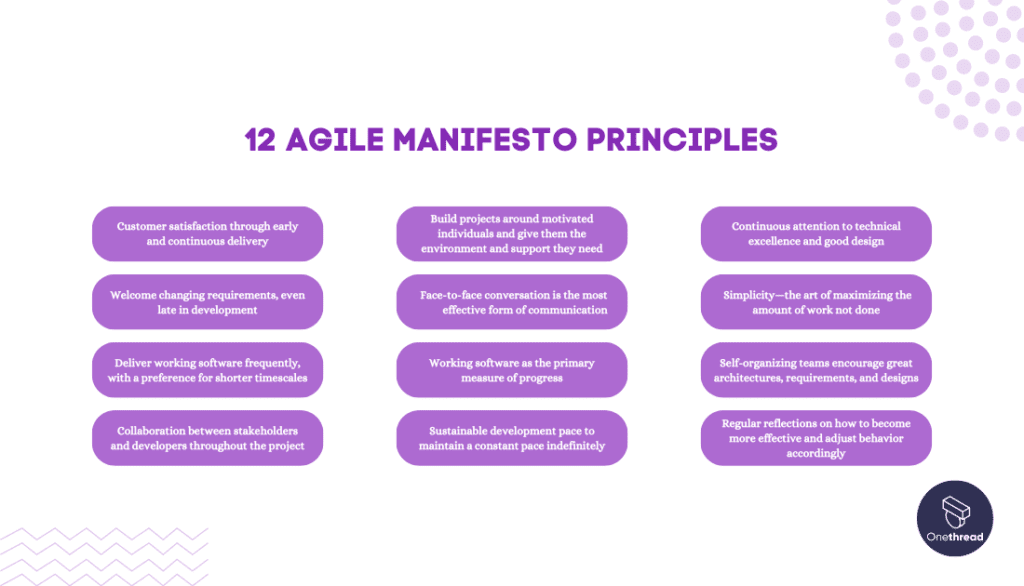
The Agile Manifesto consists of 12 principles that further elaborate on the values stated in the manifesto. Let’s delve into each principle and discuss its significance in fostering agile development practices.
- Prioritizing Early and Continuous Delivery for Customer Satisfaction:
We emphasize delivering valuable software promptly and regularly, enabling us to gather input from customers and stakeholders. This iterative approach ensures alignment with their needs, enhancing overall customer satisfaction.
- Embracing Changing Requirements, Even in Later Stages:
Change is a natural part of software development. Rather than resisting it, we remain adaptable, adjusting plans and processes to accommodate evolving requirements. This flexibility maximizes the value we provide.
- Frequent Delivery of Working Software, with Shorter Timescales Preferred:
Our goal is to release functional software in brief iterations or sprints. By delivering incremental value at regular intervals, we allow customers to benefit sooner and validate our progress early.
- Continuous Collaboration Between Stakeholders and Developers:
We stress ongoing collaboration and open communication among all stakeholders. Involving customers, developers, testers, and others fosters alignment and a shared goal throughout the development process.
- Creating a Supportive Environment for Motivated Individuals:
We acknowledge the importance of motivated team members. We provide a conducive atmosphere, encourage autonomy, and empower decision-making, fostering innovation and ownership.
- Valuing Face-to-Face Communication as Most Effective:
While recognizing the utility of tools, we prioritize face-to-face communication for its effectiveness. Direct interaction enhances understanding, quick feedback, and strong interpersonal bonds within the team.
- Using Working Software as the Primary Progress Metric:
Our focus is on delivering operational software over extensive documentation or rigid plans. Working software demonstrates tangible progress, offering a better basis for feedback and informed decision-making.
- Maintaining a Sustainable Development Pace Indefinitely:
We strive for a sustainable work pace throughout the project. This approach avoids overburdening the team, ensuring consistent productivity and the delivery of high-quality results without burnout.
- Prioritizing Technical Excellence and Sound Design:
We stress the significance of technical prowess and solid design practices. By honing our technical skills and emphasizing quality, we create a foundation for long-term success and adaptable, maintainable code.
- Valuing Simplicity to Maximize Efficiency:
We prioritize simplicity in our approach. By concentrating on essential features and minimizing complexity, we enhance efficiency, reduce waste, and mitigate the risk of errors.
- Empowering Self-Organizing Teams for Quality Outcomes:
Teams are empowered to self-organize and make decisions collectively. This autonomy encourages collaboration, creativity, and the emergence of excellent architectures, requirements, and designs.
- Regularly Reflecting and Adapting for Continuous Improvement:
We consistently evaluate our work and seek avenues for enhancement. Through retrospectives and feedback loops, we identify growth opportunities, celebrate achievements, and adjust behaviors and processes to enhance effectiveness.
Is the Agile Manifesto Relevant in 2023?
Yes, the Agile Manifesto is still highly relevant in 2023. The principles outlined in the manifesto continue to guide and shape effective software development practices in today’s dynamic and fast-paced industry. Here’s why the Agile Manifesto remains significant:
Adaptability in a Changing Landscape
The Agile Manifesto emphasizes the importance of embracing change and responding to evolving requirements. In 2023, where technology and market trends continue to evolve rapidly, agility is crucial for organizations to stay competitive and deliver value to customers.
The Agile Manifesto principles offer a structure to adjust to dynamic situations and make the most of emerging possibilities.
Customer Focus
Agile principles prioritize collaboration between stakeholders, including customers, development teams, and business representatives. This focus on close collaboration ensures that software solutions meet customer needs and expectations.
In 2023, as customer expectations continue to evolve and become more sophisticated, Agile principles provide a customer-centric approach that enables organizations to deliver valuable and user-centric products.
Iterative and Incremental Delivery
The Agile Manifesto promotes delivering working software in short iterations, allowing for continuous feedback and validation. This iterative approach enables organizations to quickly adapt to emerging requirements, incorporate customer feedback, and mitigate risks.
In 2023, where rapid deployment and frequent updates are standard practices, the Agile Manifesto’s principles support organizations in delivering value early and consistently.
Continuous Improvement
The Agile Manifesto encourages a culture of continuous improvement and learning within development teams. This principle remains relevant in 2023 as organizations strive to optimize their processes, enhance quality, and increase efficiency.
Agile practices such as retrospectives, regular feedback loops, and embracing technical excellence help teams identify areas for improvement and drive ongoing enhancement of their software development practices.
How Onethread Can Help Implement the Agile Manifesto?
Onethread, an integrated communication and collaboration tool, can support the implementation of the Agile Manifesto in the following ways:
Facilitate Effective Communication
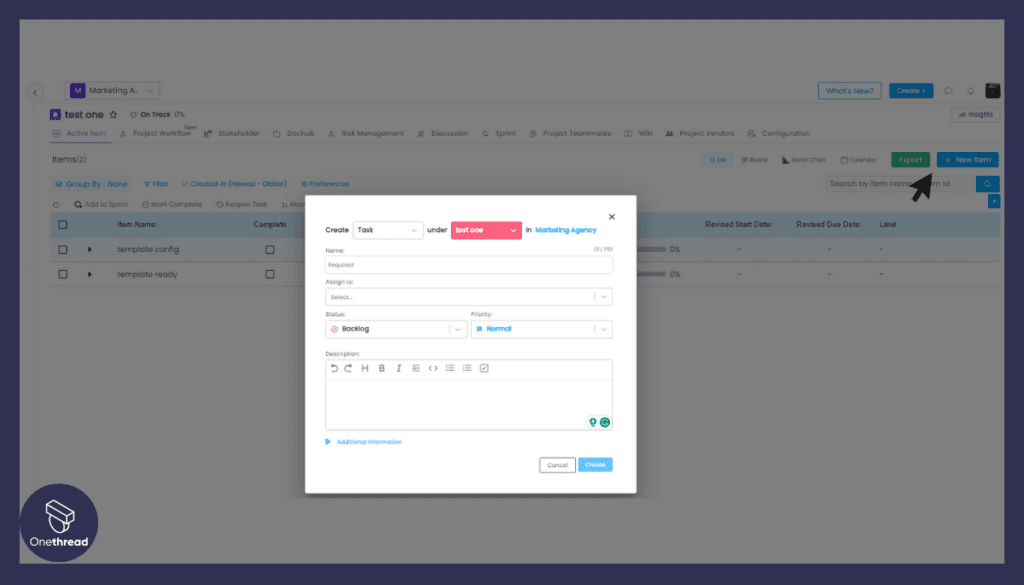
Onethread provides a platform for seamless communication among team members, promoting the “Individuals and interactions over processes and tools” principle. It enables real-time messaging, file sharing, and threaded discussions, fostering open communication and rapid information exchange.
Adaptability and Responding to Change:
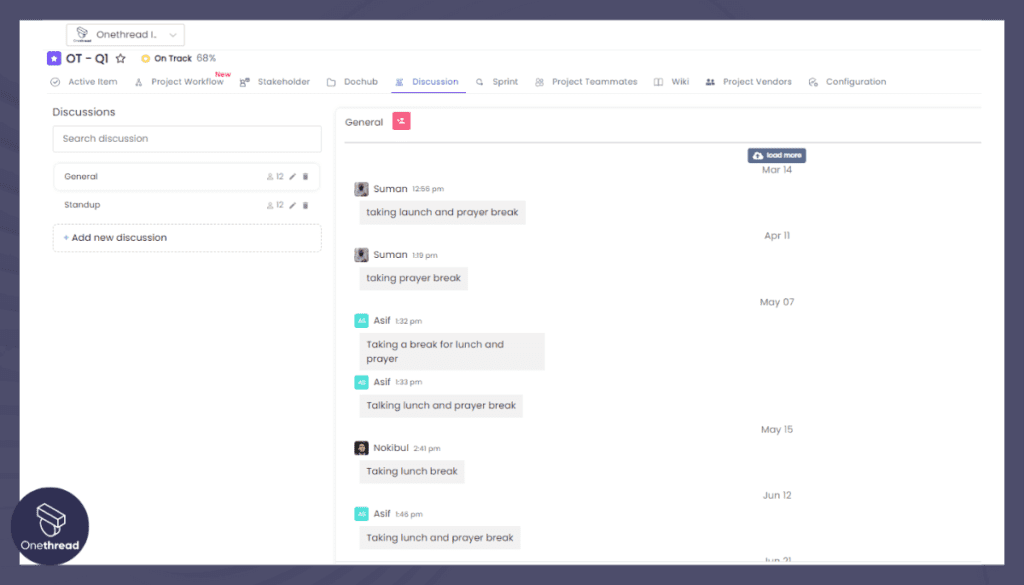
Onethread’s flexibility in organizing conversations and topics supports the “Responding to change over following a plan” principle. Team discussions can quickly shift to accommodate changing requirements, and stakeholders can provide immediate feedback, ensuring adaptability to evolving project conditions.
Promote Transparency and Visibility
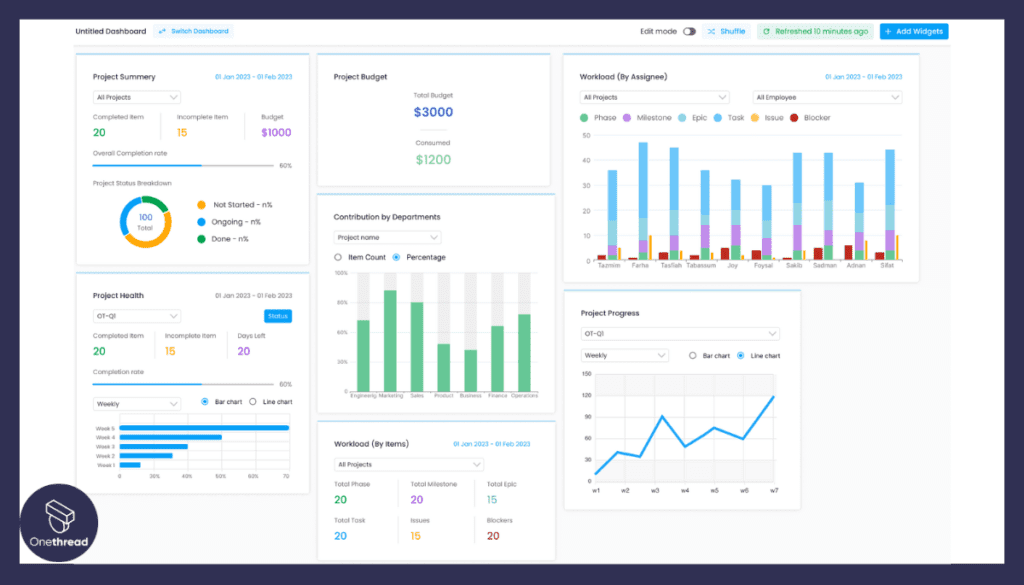
Onethread aids in delivering working software frequently, aligning with Agile’s emphasis on showing progress. Teams can share updates, demo results, and discuss iterations, fostering transparency and boosting collaboration across the organization.
Support Iterative Development
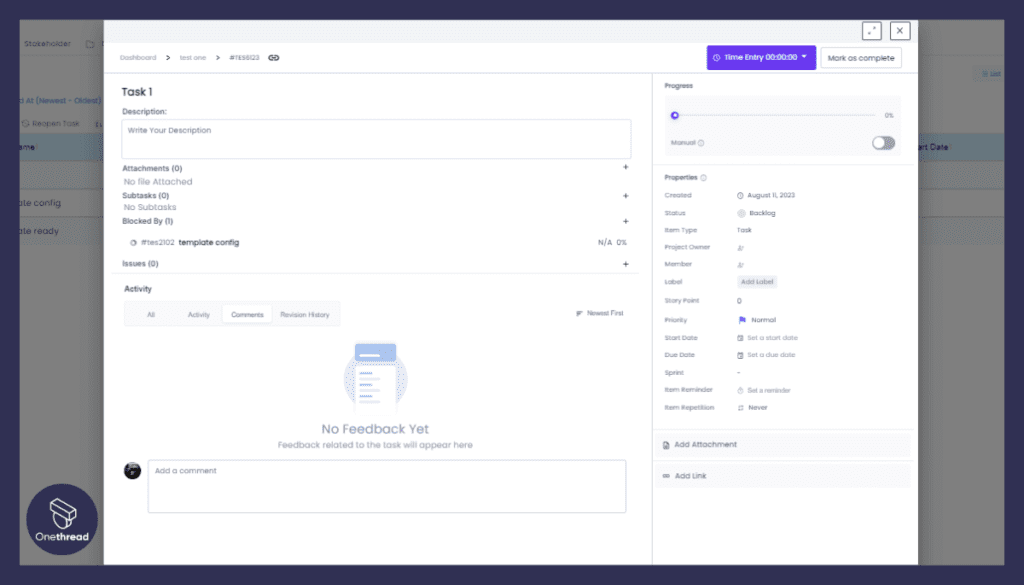
Onethread’s threaded conversations can be used to manage iterations, aligning with Agile’s iterative approach. Teams can create separate threads for each iteration, discussing goals, progress, challenges, and lessons learned, facilitating continuous improvement.
Enhance Cross-Functional Collaboration
Onethread’s platform facilitates cross-functional collaboration, allowing developers, testers, designers, and stakeholders to collaborate in a single space. This aligns with Agile’s focus on breaking down silos and promoting collaboration among different roles.
Document Sharing and Knowledge Management
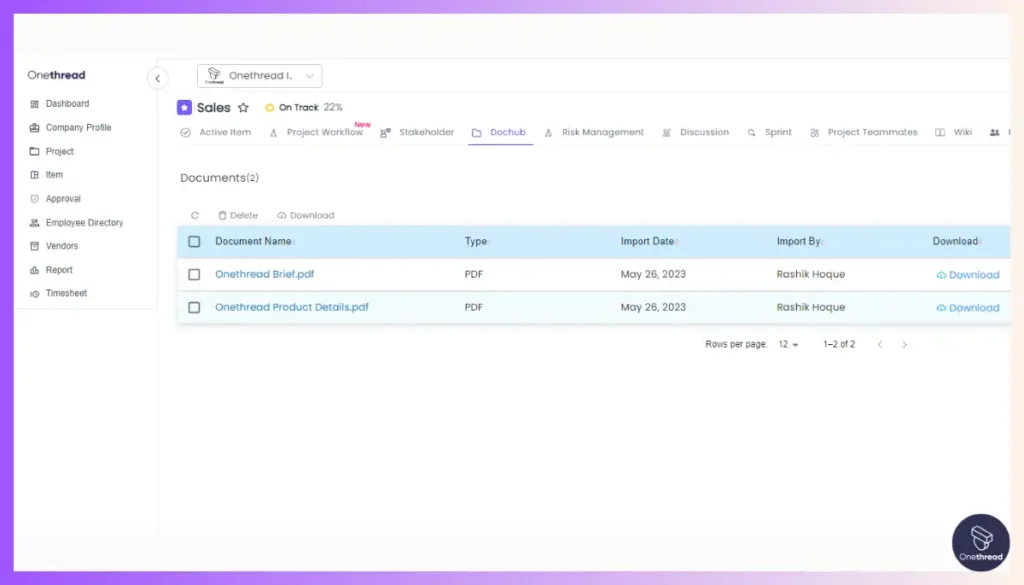
Onethread enables the sharing of documents, which aligns with the Agile principle of “Working software over comprehensive documentation.” Teams can share prototypes, wireframes, and other artifacts directly within discussions, focusing on tangible outcomes.
Real-Time Decision Making
Onethread’s instant messaging and threaded discussions enable quick decision-making, aligning with Agile’s emphasis on empowered teams. Team members can collaborate in real-time to resolve issues, make decisions, and keep projects on track.
Bottom Line
To summarize, the Agile Manifesto is a game-changer for the world of software development. It emphasizes collaboration, adaptability, and customer satisfaction. By valuing individuals and interactions over processes and tools, we can create a more efficient and effective development process.
With Agile, we can respond to change quickly, deliver high-quality software, and continuously improve our work. So let’s embrace the Agile mindset, work together, and revolutionize the way we build software. Together, we can achieve great things and delight our customers every step of the way.
FAQ
What is the Agile Manifesto’s primary purpose?
The Agile Manifesto serves as a guideline for software development, prioritizing flexibility, collaboration, and customer satisfaction over rigid processes and documentation.
How does Agile prioritize “Individuals and interactions over processes and tools”?
This principle underscores the significance of fostering effective team communication and collaboration, enabling better problem-solving and innovation.
What does “Responding to change over following a plan” mean in the Agile context?
This principle highlights the importance of adaptability, encouraging teams to embrace changing requirements and adjustments throughout the development process.
Can the Agile Manifesto be applied to large and complex projects?
Yes, Agile methodologies can be scaled to suit large projects through frameworks like SAFe (Scaled Agile Framework) or LeSS (Large Scale Scrum), ensuring flexibility and collaboration at all levels.
How does Agile’s “Customer collaboration over contract negotiation” benefit project outcomes?
This principle emphasizes continuous customer involvement, enabling better alignment with their needs, faster feedback incorporation, and ultimately, a more successful end product.
